Salamanders comprise some of the smallest to the largest amphibians in the world. Its worldwide distribution has brought about great diversity in its family. Amidst so many species, a popular question has prevailed which is the largest salamander in the world? As an answer to this question, we bring to you our today’s article, Top 17 Largest Salamanders in the World.
Top 17 Largest Salamanders in the world
17) Northern Red Salamander
The Northern Red Salamander is a medium-sized amphibian with bright orange, red to dull reddish colorations, and irregular black spots. Being a plethodontid salamander, the Northern Reds lack lungs.
The females of this species are larger than the males and lay eggs during the fall or early winter season in well-protected and hidden nests. Human activities have caused a sharp decline in this species’ population, especially in Indiana.
- Size- 4.3-7.1 in
- Scientific Name- Pseudotriton ruber
- Location- streams and aquatic areas of Eastern United States
16) Tennessee Cave Salamander
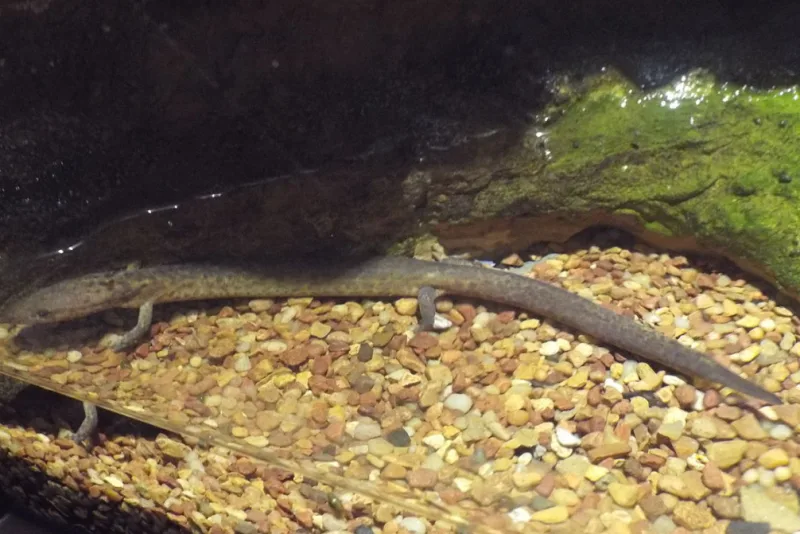
The state amphibian of Tennessee, the cave salamander, is a medium-large-sized salamander that lacks eyelids. They spend the majority of their life cycle in the larval stage and are characterized by bright, feathery external gills.
Its survival depends greatly on the water quality and is a highly threatened species due to water pollution, trash dumps, etc. Amphipods and other small water invertebrates, including crustaceans, earthworms, beetles, stoneflies, and mosquitoes, make up the majority of the salamander’s diet.
- Size- 4-7.5 in
- Scientific Name- Gyrinophilus palleucus
- Location- Restricted limestone cave systems in Tennessee, Georgia, and Alabama
15) Reticulated Flatwoods Salamander
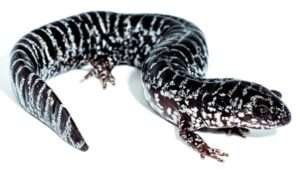
The next species on our list of Largest Salamanders in the world is a small-medium-sized salamander, the Reticulated Flatwoods Salamander. This species has a long, slender body, a body color that is silvery black with white markings.
Earthworms and spiders are the main sources of food for reticulated flatwood salamanders. Ambystoma bishopi, a type of burrowing salamander, dwells in the fallen leaves beneath longleaf pine and wiregrass in the ecosystems of the flatwood coastal plain.
- Size- 5.2
- Scientific Name- Ambystoma bishopi
- Location- South Eastern Coastal Plains of the US
14) Jefferson Salamander
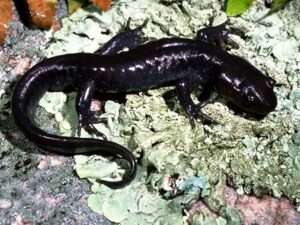
The Jefferson Salamander is a species of mole salamander that lives in burrows and has well-adapted lungs for this activity. On its dorsal surface, it is often black, brown, or dark grey; on its anterior, it is usually a lighter hue.
These carnivorous salamanders are slim and have a large nose and long toes, which is a distinctive feature.
- Size- 4.5-7 in
- Scientific Name- Ambystoma jeffersonianum
- Location- Native to the Northeastern US and Ontario
13) Eastern Tiger Salamander
Eastern Tiger Salamanders begin as aquatic larvae with external gills and a caudal fin but can metamorphose into terrestrial adults.
Some larvae may not even undergo metamorphosis, remaining in their larval form and becoming sexually mature while in the water. This dual-life strategy sets them apart from many other amphibians.
While tiger salamanders are hardy and immune to diseases, they can transmit pathogens like Batrachochytrium dendrobatidis and ranaviruses.
Their use as fishing bait has been linked to the spread of these diseases, leading to severe mortality in some populations.
- Size- 6-8 inches (15-20 cm)
- Scientific Name- Ambystoma tigrinum
- Location– North America particularly from New York to Florida.
12) California Tiger Salamander
Next up, we have a large, stocky salamander species, the Californian Tiger Salamander.
This salamander has a broad, rounded head, and its wide mouth gives off the impression of smiling. Small eyes with black irises protrude from the head.
The distinctive yellow or white spots on all California tiger salamanders against the animal’s basal black color back, sides, legs, and tail, serve to be an important identifying character.
- Size- 8 in (males), 6.8 in (females)
- Scientific Name- Ambystoma californiense
- Location- Native species of California
11) Axolotl
Commonly known as “water dogs,” the axolotl is the 11th largest salamander in the world. The axolotl retains its larval features, like external gills.
Their eyes lack lids, and their skulls are broad. Their limbs are undeveloped, and their digits are long and slender.
Because of their exceptional regeneration abilities, axolotls are vital in scientific research facilities.
They can fully regenerate lost limbs, fingers, hearts, eyes, and even portions of the brain. Their resistance to cancer is also almost a thousand times greater than humans.
- Size- 6-18 in
- Scientific Name- Ambystoma mexicanum
- Location- Originally occurring in the lakes of Mexico City and Mexico
10) Common Mudpuppies
Mudpuppies are medium-sized amphibians, typically having blackish-blue patches and a rusty brown tint. As adults, mudpuppies can be 20 cm (8 in) long and continue to grow to an average length of 33 cm (13 in).
Their size is dependent on the amount of oxygen in the water, and their external gills resemble the plumes of an ostrich. Typically they prey upon animals such as insects, mollusks, annelids, crayfish, and other invertebrates and small fish.
- Size- 8-13 in
- Scientific Name- Necturus maculosus
- Location- Eastern North American water bodies
9) Lesser Siren
Next up on our list of the Largest salamanders in the world we have the Lesser Siren. They have two legs with four toes on each, located behind the base of the skull. In particular, lesser sirens are neotenic species and retain their external gills throughout their lives.
The lesser siren is a nocturnal creature that hides during the day at the bottom of water bodies, in the mud, and in other substrates. The majority of their diet consists of aquatic invertebrates, such as worms, insects, larvae, and even other tadpoles and amphibians.
- Size- 7-27 in
- Scientific Name- Siren intermedia
- Location- Native to the US and Northern Mexico
8) Greater Siren
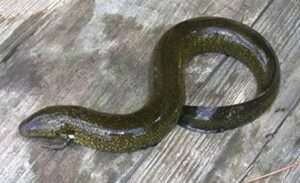
Next up on our list of the largest salamanders in the world, is the Greater Sirens. These large salamanders have two forelimbs, a flat tail, and external gills. They resemble eels in appearance due to their reduced forelimbs, which have four toes each, and lack of rear limbs.
Their skin is grayish brown or olive in hue, with yellow and black streaks along the length of it. Greater sirens are nocturnal creatures that prey largely on crustaceans and small fish.
- Size- 7-38 in
- Scientific Name- Siren lacertina
- Location- Coastal Plains of Southeastern US
7) Two-toed Amphiuma
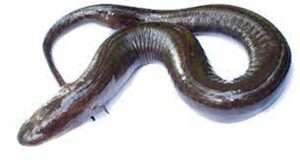
The two-toed Amphiuma is one of the largest amphibians in the world and also the longest. The color is gray to black on the dorsal side and becomes lighter on the ventral. Amphiumas are less aquatic, and it appears that they lay their eggs on the land rather than exclusively in water.
Although not poisonous, the two-toed amphiuma is renowned for its powerful bite. They consume fish, tiny invertebrates, and even other amphiumas as food.
- Size- 13.7-45 in
- Scientific Name- Amphiuma means
- Location- Southeastern United States
6) Coastal Giant Salamander
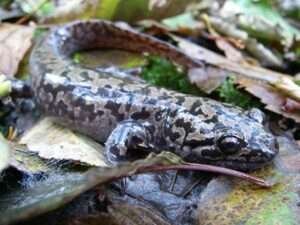
The Coastal giant salamander can reach a maximum total length of 34 cm (13 in) and is the largest terrestrial salamander in North America.
The dorsal skin of most adults is dark brown to nearly black and covered in light brown patches or marbling, though the color varies between individuals and communities.
Coastal Giant Salamanders have pale underbellies and black dorsal coloration with shovel-shaped heads, gills, and tail fins.
- Size- 13 in
- Scientific Name- Dicamptodon tenebrosus
- Location- Pacific Northwest (California, Oregon, British Columbia)
5) The three-toed amphiuma
The three-toed amphiuma bears a striking eel-like appearance marked by an elongated, dark gray-black, or brown body.
They have tiny, vestigial legs that are barely noticeable, resembling thread-like appendages often going unnoticed.
The three-toed amphiuma inhabits heavily vegetated areas of permanent, slow-moving bodies of water, such as swamps, ponds, and lakes.
Their diet is highly diverse, consisting of earthworms, fish, crustaceans, and a wide variety of small invertebrates. This diversity has posed a challenge for fishermen, as these creatures will eat almost anything that swims.
- Size- 18-30 inches (individual may occasionally reach a staggering length of 41.25 inches)
- Scientific Name- Amphiuma tridactylum
- Location– Southeastern United States
4) Hellbender

The Hellbender is a gigantic amphibian that only dwells in water. Its body is typically dark grey or brown, with a few dark spots strewn down the back, a flat head, and a wrinkled body.
The Hellbender is the largest salamander in North America and the sixth heaviest amphibian in the world, weighing four to five pounds (1.8 to 2.3 kg). Adults usually measure 20 inches, although they can grow as long as 29 inches.
- Size- 20 in
- Scientific Name- Cryptobranchus alleganiensis
- Location- United States of America
3) Japanese Giant Salamander
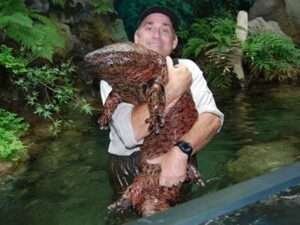
The next salamander on our list of Largest Salamanders in the world is the second largest salamander on the planet, the Japanese Giant Salamander. They have a lengthy body that is covered in a wrinkled, green, black, and grey epidermis that serves as concealment.
Japanese Giant salamanders are mostly water dwellers. Amazingly capable of regeneration, giant salamanders can create new skin and bone. They have a very slow metabolism and are carnivorous, eating a variety of creatures, including fish, crayfish, snails, and small mammals.
- Size- 1.5 m (5 ft)
- Scientific name- Andrias japonicus
- Location- Southwest Japan
2) Chinese Giant Salamander
With maximum lengths of 5.8 ft, the Chinese Giant Salamander sits at the top of all amphibians, along with its close relative, the South China Giant Salamander. It has a big head, tiny eyes, and wrinkled, dark skin.
Its flat, broad head has round lidless eyes and a big mouth. Color varies from brownish tones, dark reddish, to even black, but it is often a dark brown with a speckled pattern.
It can weigh up to 50 kg (110 lb) and primarily feeds on invertebrates like insects, millipedes, crabs, and even other amphibians (both frogs and salamanders), fish, etc.
- Size- 5.8 ft
- Scientific Name- Andrias davidianus
- Location- Yangtze River Basin (Central China)
1) South China Giant Salamander

The first animal in our list of the Largest Salamanders in the world is a close relative of the Chinese Giant Salamander. The South China gigantic salamander may be both the world’s largest amphibian and the largest species of salamander.
It is exclusively found in the Pearl River valley in southern China, south of the Nanling Mountains. As a delicacy and used in traditional medicine in China, the South China giant salamander has been so overharvested that it is possibly extinct in the wild.
- Size- 5.9 ft
- Scientific Name- Andrias sligoi
- Location- Southern China (Pearl River Basin)
This is where we conclude our article. Hope you like it. We intend to bring many more articles soon, so stay tuned until then.
Also Read:

Hi everyone, my name is Shawna, and I’ve always been fascinated by the fascinating diversity of flora and fauna that our nature has in it. I am currently studying biotechnology and am particularly interested in animal biotechnology, delving into the intricate processes that define their true nature and uniqueness.
